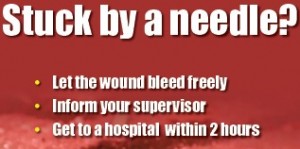
Photo credit: Jolene Jang/Flickr This exact garbage can is not the one referred to in this post
She took precautions and followed protocol, but somehow it still happened.
“I was pricked with a used hypodermic while changing the garbage,” said Heidi, who worked as a barista in downtown Vancouver a few years ago.
“I was wearing sharps-resistant gloves, with a clear garbage bag that I had scanned for sharps, and I held it away from my body. Then the bag swung and bumped against the wall. The needle went into my unprotected knee.”
She said her coworker called an ambulance and “911 told us we needed to bring the needle in order for workers’ comp and insurance to cover the cost of the ambulance and treatment.” The medical history of the person who had used the needle was unknown, so Heidi took an “antiretroviral cocktail for 28 days, hepatitis vaccines, and 12 months of bloodwork.”
“The needle could have been from meds (insulin, or the like) but the area has a high incidence of HIV/AIDS and hep. It was all pretty scary, but fortunately, I’m fine.”
Outspoken about safety
Today Heidi works as a special education assistant and occasionally takes shifts as a waitress in a local restaurant. She says she’s “super anal and outspoken at all of these places, particularly about safety.” She asked me about a WorkSafeBC publication that came out after her incident.
“I was told that a handbook was in the works regarding this type of injury, but I never did see the final product,” she said.
The publication Heidi speaks of is Controlling Exposures: Protecting Workers from Infectious Disease. It points out that while health care workers face greater risk of exposure to infectious diseases, there is also a risk for workers in law enforcement, corrections, dentistry, funeral homes, hospitality, schools, animal hospitals, construction, and food processing.
Another great resource is WorkSafeBC’s Stuck by a needle? poster (pictured above), which can be adapted for individual workplaces. It lists three steps to follow if you are stuck with a needle and includes space at the bottom for filling in the name and address of the nearest hospital. Posting it on the wall is one way to help employees who find themselves in Heidi’s situation.
Employers in BC are required to follow the precautions outlined in Regulation Part 6 Substance Specific Requirements – Biological Agents.
Thanks to Heidi for sharing her story, and please let me know if you have a story of your own.



